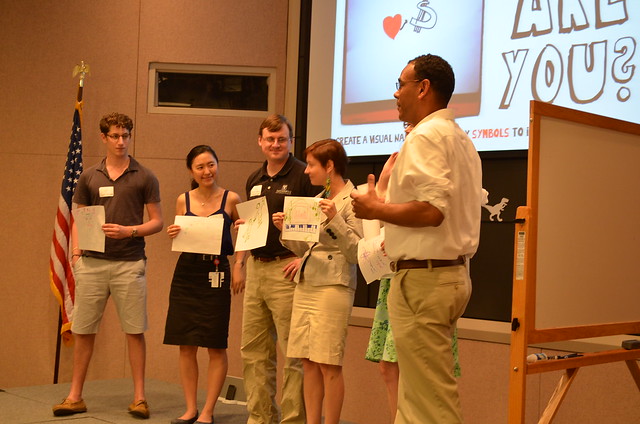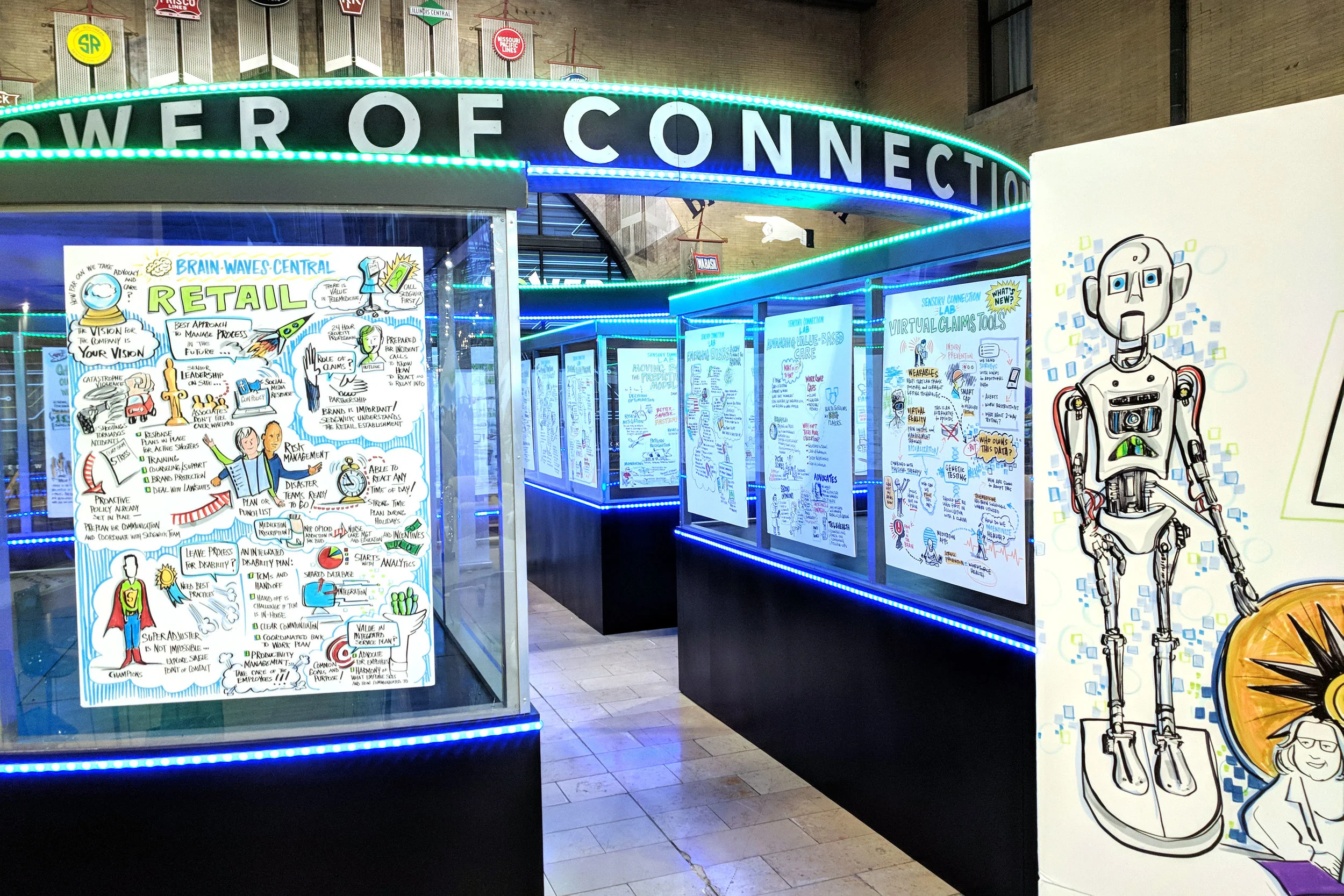That Creative Space: An Intermediate Course for Graphic Facilitators
/NOW ENROLLING STUDENTS...
 More About the Course | Sign Up Today
More About the Course | Sign Up Today
Vanderbilt Creative Practice Bootcamp at the Curb Center
/On Septermber 2nd, 2011, I went with Peter Durand and Perrin Ireland to The Curb Center at Vanderbilt University to support Peter as he offered a Creative Practice Bootcamp on graphic faciliation. I also had the honor of scribing for Parker Gates, designer and faciliator for the design studio at e+ CancerCare, located in Nashville, TN. And finally, I even got to sit in as a participant on a session by Eric Booth, teaching artist, actor, author, and international arts learning consultant, on Habits of Creative Problem Solving.
How to Unleash Your Creativity
/By Mariette DiChristina
I, too, have found the creative process to be teachable and trackable. |
Meeting on the Right Side of the Brain
/Congrats to Leslie Marquard and Catalyst Ranch on leading the piece. Thanks for bringing "right-brained thinking" to a "left-brained" world. (Actually, working in creative environments and using multiple learning modalities inspires whole-brain thinking.)
|
Quieting the Demons and Giving Art a Voice
/
|
How I Live: A study of an ethnographic self-study
/She documents almost everything she does or creates on her website and has just jumped into audio podcasting, too.
I needed to clean the apartment. Instead of cleaning the apartment, I took pictures of the mess in the apartment. It's a colorful mess. A muffin tin holding plastic bags of beads and some jewelry tools. Haven't worked on jewelry in a long time, so this has been sitting out for a long time. Da guys on the shelf next to the movie chair, owl, creature from the black lagoon, Stripus McGreenley the sock monkey, water bottle, more Mr. Sketch markers, Good magazine. |
Embrace the Edge -- or Perish
/ The periphery of today's global business environment is where innovation potential is the highest. Ignore it at your peril.
The periphery of today's global business environment is where innovation potential is the highest. Ignore it at your peril.
Article by John Hagel and John Seely Brown
Edges are increasingly significant as the global business environment speeds up. In a world of accelerating change, what's born on the edge transforms the core with breathtaking speed. A few short years ago, both India and China were marginal players in the global economy. Now they are central players. Not long ago, the Internet was a specialized communication platform for scientists. Now it's a center for commerce and advertising.
|
Making Art Work @ Catalyst Ranch
/
It may be years since most white-collar businesspeople went to art class, but a new corporate training philosophy might change the way Chicago does business.
The West Loop’s Catalyst Ranch teamed up with the Art Institute to develop an arts-based corporate training philosophy unlike any other.
Aptly named Art-Work, the program utilizes the museum’s artwork as a medium for teaching communication and other business-related skills.
Catalyst Ranch, which specializes in hosting eccentric off-site meetings and events for various companies, developed Art-Work in conjunction with the Art Institute as an alternative means to the typical corporate teambuilding activities. The day-long sessions use the museum’s vast collections to illustrate and teach business concepts, and also utilize the creative working environment inside Catalyst Ranch to further develop ideas, according to Bobbie Soeder, explorer/matchmaker (aka vice president of sales and marketing) at Catalyst Ranch.
“Arts-based learning isn’t a new concept,” Soeder said. “But we feel that it’s so timely right now with today’s business climate and the push for creativity and innovation.”
The first half of the session takes place at the Art Institute, where co-workers view hand-selected artworks and discuss how some of the various elements can be related to the business world. Art-Work sessions are co-taught by Sarah Alvarez, the assistant director of Adult Programs in Museum Education at the Art Institute, and a corporate facilitator contracted by Catalyst Ranch. Alvarez brings her knowledge of art history and visual learning to each session while a corporate facilitator is chosen based on their specialized knowledge in one of four categories: communication, creativity and innovation, diversity and inclusion and team and leadership development.
The “Art-Work” training program combines art and corporate business.
“I’ll get a group of people in front of a work of art and I’ll ask every one of them to say the first thing they see,” Alvarez said. “Nine times out of 10 you’ve got almost everybody saying something different. It’s this reminder that we all see the world slightly differently and art is a really great way to have those kinds of discussions about how we see it.”
The second half of the session takes place back at Catalyst Ranch where the group reviews the concepts discussed at the museum and works with Alvarez and the corporate facilitator to make solid connections between the art and their particular business issues.
Facilitators are contracted based on their area of specialization, and Catalyst Ranch chooses from a handful of those known as experts in corporate training. If the staff is having difficulty with communication, Alvarez and the corporate facilitator will choose artwork they feel will help the team fine-tune their communication skills, she said. If cooperation, diversity or other sensitive issues are plaguing the group, the co-facilitators can select works from the museum that will create an environment conducive for healthy discussion about the topic.
“The art is beautiful and it’s incredible but there are skills to be refined, discovered [and] honed that apply back to the daily way that group will work with each other,” Soeder said. “It causes people to feel safer because they’re directing their conflict to the art rather than to each other.”
Aside from simply being a means for learning age-old corporate lessons, Art-Work is designed to help employers keep their staffs thinking in creative, innovative ways. By having both an art expert and a corporate guru on-hand, clients are exposed to a dichotomy they might not otherwise have thought to explore, Alvarez said.
“Our driving goal is to engage audiences that think they don’t have time ... for a museum, to realize that, maybe, they do,” she said. “It’s not about coming in with a degree in art history or being able to paint something or other. It goes beyond that.”
Though no Art-Work sessions have been scheduled yet, both the Art Institute and Catalyst Ranch are hopeful based on the history of satisfied clients they’ve each seen in the past. The Art Institute has worked with other businesses, teachers and medical professionals in arts-related programs, and Catalyst Ranch has hosted a slue of creative meetings and events for corporations across the country.
Amy Shannon said she was one of the first to bring her staff to an off-site meeting at Catalyst Ranch when it opened five years ago. Though it may take corporate-types a bit of time to feel comfortable in an arts environment, Shannon believes the Art-Work program has great potential for teambuilding.
“In some ways it puts people on a level playing field because I suspect there’s not too many [people] out there that are in fact themselves experts in the arts,” Shannon said. “It enables people to come at a conversation from a bit of a different slant than what they might normally.”





































